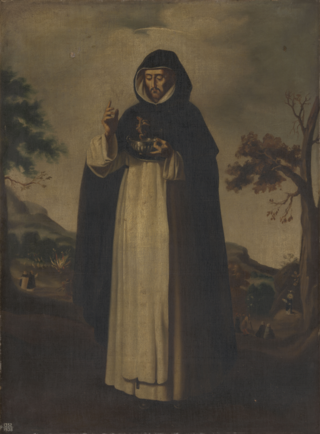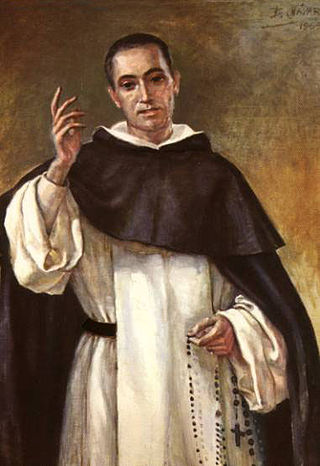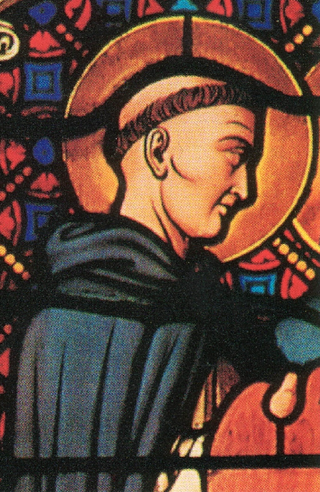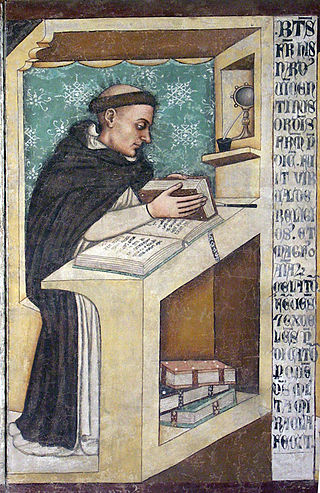
Caterina di Jacopo di Benincasa, known as Catherine of Siena, was an Italian mystic and pious laywoman who engaged in papal and Italian politics through extensive letter-writing and advocacy. Canonized in 1461, she is revered as a saint and as a Doctor of the Church due to her extensive theological authorship. She is also considered to have influenced Italian literature.

The Order of Preachers, also known as the Dominican Order, is a Catholic mendicant order of pontifical right that was founded in France by a Castilian priest named Dominic de Guzmán. It was approved by Pope Honorius III via the papal bull Religiosam vitam on 22 December 1216. Members of the order, who are referred to as Dominicans, generally display the letters OP after their names, standing for Ordinis Praedicatorum, meaning 'of the Order of Preachers'. Membership in the order includes friars, nuns, active sisters, and lay or secular Dominicans. More recently, there has been a growing number of associates of the religious sisters who are unrelated to the tertiaries.

Pope Gregory IX was head of the Catholic Church and the ruler of the Papal States from 19 March 1227 until his death in 1241. He is known for issuing the Decretales and instituting the Papal Inquisition, in response to the failures of the episcopal inquisitions established during the time of Pope Lucius III, by means of the papal bull Ad abolendam, issued in 1184.

Pope Innocent V, born Pierre de Tarentaise, was head of the Catholic Church and ruler of the Papal States from 21 January to 22 June 1276. A member of the Order of Preachers, he acquired a reputation as an effective preacher. He held one of the two "Dominican Chairs" at the University of Paris, and was instrumental in helping with drawing up the "program of studies" for the Order. In 1269, Peter of Tarentaise was Provincial of the French Province of Dominicans. He was a close collaborator of Pope Gregory X, who named him Bishop of Ostia and raised him to cardinal in 1273.

Bernardino of Siena, OFM, was an Italian Catholic priest and Franciscan missionary preacher in Italy. He was a systematizer of scholastic economics.

Doctor of the Church, also referred to as Doctor of the Universal Church, is a title given by the Catholic Church to saints recognized as having made a significant contribution to theology or doctrine through their research, study, or writing.

Hyacinth was a Polish Dominican priest and missionary who worked to reform the women's monasteries in his native Poland. Educated in Paris and Bologna, he was a Doctor of Sacred Studies.

Saint Dominic,, also known as Dominic de Guzmán, was a Castilian Catholic priest and the founder of the Dominican Order. He is the patron saint of astronomers and natural scientists, and he and his order are traditionally credited with spreading and popularizing the rosary. He is alternatively called Dominic of Osma, Dominic of Caleruega, and Domingo Félix de Guzmán.

John of Wildeshausen, O.P., also called Johannes Teutonicus was a German Dominican friar, who was made bishop of Bosnia and later the fourth master general of the Dominican Order.

The Third Order of Saint Dominic, also referred to as the Lay Fraternities of Saint Dominic or Lay Dominicans since 1972, is a Catholic third order which is part of the Dominican Order.

Louis Bertrand, OP was a Spanish Dominican friar who preached in South America during the 16th century, and is known as the "Apostle to the Americas". He is venerated as a saint by the Catholic Church.

Giovanni Dominici, OP was an Italian Catholic prelate and Dominican who became a cardinal. His ideas had a profound influence on the art of Fra Angelico, who entered the Dominicans through him.

Raymond of Capua, was a leading member of the Dominican Order and served as its Master General from 1380 until his death. First as Prior Provincial of Lombardy and then as Master General of the Order, Raymond undertook the restoration of Dominican religious life. For his success in this endeavor, he is referred to as its "second founder".

The 17 Thomasian Martyrs were the 12 Dominican priests, 1 Franciscan priest and 3 Dominican bishops who became administrators, professors, or students in the University of Santo Tomas in Manila, they are venerated in the Catholic Church regarded them as a martyrs and declared as a saints and blesseds by several popes throughout the 20th and 21st century, All of them gave up their lives for their Christian faith, some in Japan, others in Vietnam, and in the 20th century, in Spain during the Spanish Civil War. Lorenzo Ruiz de Manila was among the lay companions of the Thomasian Martyrs of Japan, their feast day is celebrated every year on November 6.

Francisca del Espíritu Santo de Fuentes was a Spanish Roman Catholic religious sister. She became the first prioress of the Congregation of the Dominican Sisters of St. Catherine of Siena in the Philippines.

Giacomo Salomoni, OP was an Italian Catholic priest and a professed member of the Order of Preachers. He was a noted ascetic known for being prone to ecstatic states on a frequent basis; he served as a prior of several convents until he settled in Forlì, where he remained until his death.

Francisco Coll Guitart, OP was a Spanish Catholic priest of the Order of Preachers and founder of the Dominican Sisters of the Annunciation of the Blessed Virgin.
Giacomo Bianconi was an Italian Roman Catholic priest and a professed member of the Order of Preachers. Bianconi - who hailed from Umbria - joined the order in his adolescence and dedicated his pastoral career to his flock and on one notable occasion aided refugees when Frederick II sacked the area in 1248. He also combatted heresies and managed to convert one of their chief propagators while also distinguishing himself through his life of extreme poorness that went past the Dominican standards.

André Abellon, O.P. was a French Roman Catholic priest and a professed member from the Order of Preachers. He became a Dominican after hearing the preaching of Vincent Ferrer and studied art before joining their ranks. Abellon gained fame as a noted preacher and confessor but became a prominent figure after tending to victims of the plague in Aix-en-Provence in 1445. He was also a noted artist and painter with some of his works still surviving at present.

Isnardo da Chiampo, OP was an Italian Catholic priest and professed member in the Order of Preachers.



















